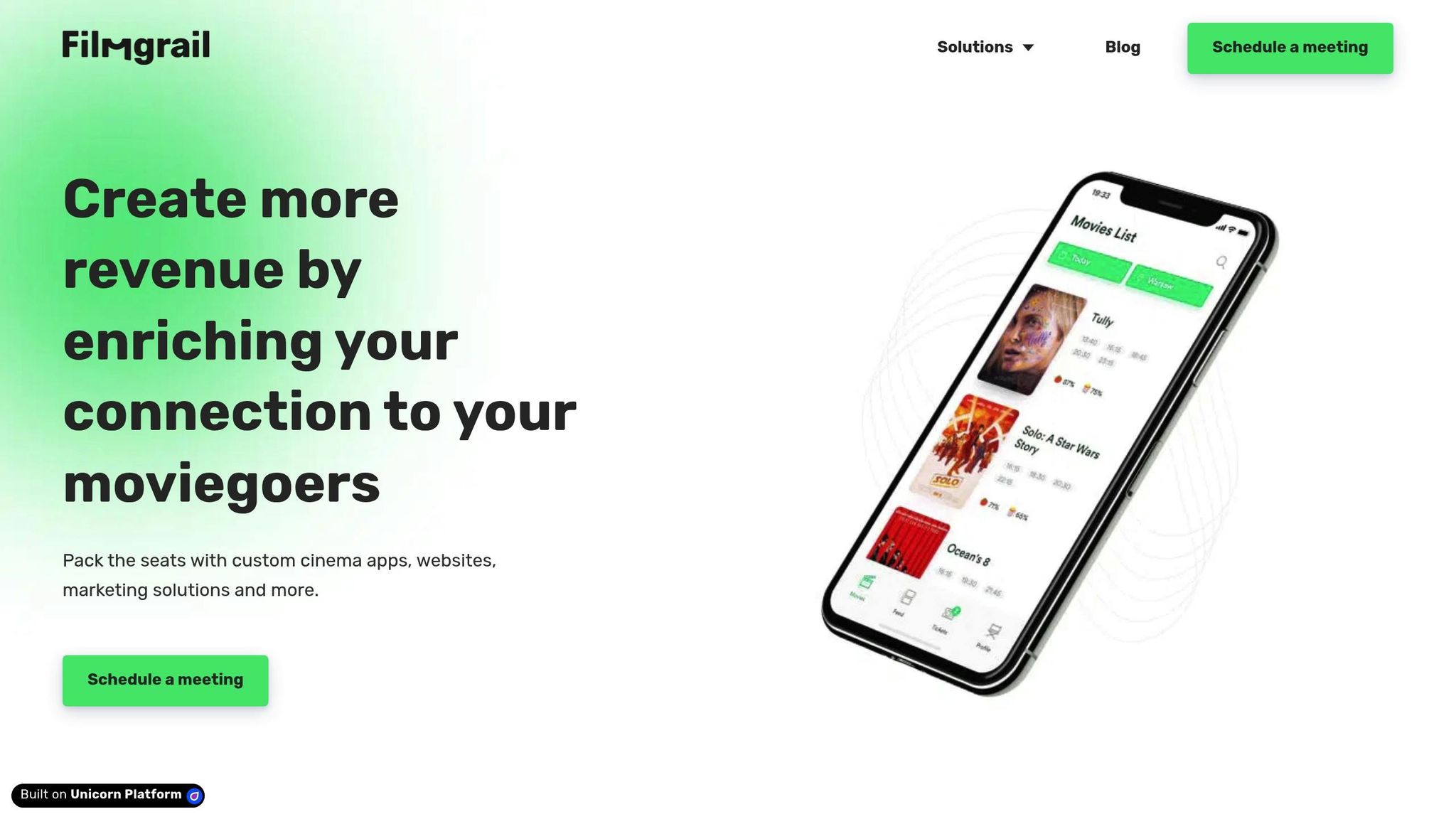Digital asset analytics is transforming how cinemas market movies and sell tickets. By analyzing data from trailers, posters, and social media, theaters can identify what drives ticket purchases and improve their marketing strategies. Here’s what you need to know:
- Impact on Sales: Analytics can increase digital ticket sales by 89% annually and quadruple audience engagement.
- Key Metrics: Tracks conversion rates, audience demographics, and campaign performance to pinpoint effective strategies.
- Personalization: Builds profiles for 90% of users, enabling targeted campaigns and loyalty programs.
- Real-Time Adjustments: Tools like dynamic pricing and A/B testing optimize campaigns instantly.
- Local Insights: Helps theaters cater to specific audience preferences and improve programming.
Cinemas using platforms like Filmgrail report higher engagement and revenue growth, proving that data-driven marketing is essential for thriving in today’s competitive entertainment landscape.
Movie theaters eye new tactics to improve ticket sales
What Digital Asset Analytics Means for Cinemas
Digital asset analytics involves tracking every digital interaction - from the first trailer view to the final ticket purchase - to make informed decisions that can directly increase ticket sales. For cinemas, this approach replaces guesswork with actionable insights that drive revenue. The importance of these tools is reflected in the growth of the cinema ticketing systems market, which is valued at about $3.2 billion in 2024 and is expected to reach nearly $7.8 billion by 2032.
By building detailed customer profiles for 9 out of 10 users, cinemas gain valuable insights into audience behavior, enabling more personalized and effective engagement. This shift transforms anonymous visitors into loyal, repeat customers. These insights set the stage for deeper discussions about the types of digital assets and the measurable outcomes they deliver.
Main Digital Asset Types in Cinema Marketing
Cinema marketing relies on several essential digital assets to connect with audiences and boost ticket sales. Movie trailers are a standout tool, as research shows they increase ticket sales by 40% more than digital previews. This underscores the importance of choosing and placing assets strategically to maximize conversions.
Other key assets include digital posters and banners, which create eye-catching visuals for websites and social media, and social media campaigns that use posts, ads, and stories to expand reach and encourage sharing. Cinemas also use push notifications via mobile apps to send timely updates about new releases, special deals, and tailored recommendations.
In addition, email marketing campaigns, such as newsletters and promotional offers, help maintain communication with subscribers. The real challenge lies in understanding how these assets work together and identifying the combinations that drive the best results.
What Data Gets Measured
Tracking the right metrics is essential for understanding the effectiveness of digital assets. Key metrics include engagement rates (views, clicks, shares, likes), conversion rates, audience demographics, and performance across different platforms.
- Conversion rates are the ultimate measure of success, showing how many people buy tickets after interacting with specific marketing assets. This data helps pinpoint which channels and content types are most effective at driving sales.
- Audience demographics - such as age, gender, and location - add context to performance data. This allows cinemas to tailor their marketing strategies to different audience segments for better results.
- Cross-platform campaign performance reveals which marketing channels are the most effective. For instance, analytics might show that email campaigns outperform social media ads for certain genres, enabling cinemas to allocate resources more effectively.
The scale of data collection in this field is remarkable. Movio, a leader in cinema analytics, collects data from 9.8 million cinemagoers in the UK alone, offering a wealth of insights to refine marketing strategies. These insights also enable predictive analytics, which can forecast ticket demand by analyzing past sales, film performance, and external factors like weather or competing events. This level of detail allows cinemas to adapt quickly and make smarter decisions.
Problems with Marketing Without Digital Asset Analytics
When cinemas operate without digital asset analytics, they face challenges like lost revenue, weaker customer relationships, and inefficient operations. These issues highlight the need for a data-driven approach to marketing.
Wasted Marketing Budget
Skipping analytics tools can come at a high cost. Cinemas often lack clarity on how their marketing dollars are spent. For example, standard ticketing websites and apps generate only a quarter of the engagement seen with more advanced analytics solutions. This means cinemas are investing in campaigns but seeing far less return on those efforts.
Historically, studios have also struggled to measure how advertising impacts ticket sales. Without reliable data, they’ve had to rely on assumptions when allocating budgets. Gabriel Swartland of Vista Group highlights this gap, saying, "exhibitor data brings significant value to studio and platform marketing, enabling better control and optimization of ad performance".
The absence of analytics tools leaves cinema operators guessing which digital assets - like trailers, social media posts, or email campaigns - actually drive ticket sales. This guesswork often results in spending on ads that generate clicks but fail to convert viewers into buyers, creating a cycle of ineffective campaigns that drain resources.
Missed Opportunities for Personalized Marketing
Without analytics, cinemas lose the ability to understand their customers on a deeper level. This lack of insight prevents them from delivering the tailored experiences that today’s audiences expect.
For instance, without detailed user profiles, cinemas can’t identify whether someone prefers action movies over comedies, enjoys weekend matinees, or engages more with emails than push notifications. This forces cinemas to rely on generic campaigns, missing opportunities to offer targeted promotions or loyalty rewards that could boost revenue and enhance customer satisfaction.
Difficulty Measuring ROI
One of the biggest frustrations for cinema operators is the inability to gauge the effectiveness of their marketing. Without digital asset analytics, it’s nearly impossible to connect marketing spend to ticket sales in a meaningful way.
Traditional marketing methods provide limited visibility into the customer journey, making it hard to determine if a ticket purchase resulted from a specific campaign or unrelated factors. This lack of clarity undermines efforts to calculate ROI and make informed decisions about future marketing investments.
Additionally, without clear attribution data, cinemas struggle to refine their marketing strategies. The inability to link spending to outcomes leads to inefficient resource allocation and missed opportunities to maximize revenue. Simply put, without analytics, marketing becomes a guessing game, and the results often fall short.
sbb-itb-b1b0647
How Digital Asset Analytics Increases Ticket Sales
Digital asset analytics takes the guesswork out of cinema operations, offering actionable insights that help theaters make smarter decisions and boost their revenue.
Improving Campaigns with Live Data
Real-time analytics allows cinemas to fine-tune their campaigns on the fly. Whether it’s adjusting ticket prices, testing creative materials, or refining targeting strategies, these instant updates help drive more ticket sales.
Take dynamic pricing, for example. This model adjusts ticket prices based on real-time demand and other factors, letting theaters capitalize on peak periods while offering discounts during slower times. It’s a proven way to maximize revenue.
Studios are also leveraging analytics to directly tie ad spend to ticket purchases. By connecting these dots, they eliminate the long-standing uncertainty in cinema marketing, ensuring every dollar spent delivers measurable results.
A/B testing has become another critical tool. Cinemas can experiment with different trailers, promotional offers, or even website designs to see what resonates most with their audience. These data-driven trials lead to more effective campaigns and better revenue outcomes. Accurate lead tracking with MagicTag allows creators and platforms to reconnect with users who show interest but leave before completing a signup.
All these real-time adjustments open the door to more personalized and engaging customer experiences.
Creating Custom Outreach and Engagement
Generic marketing is a thing of the past. Thanks to analytics, cinemas can now craft personalized campaigns tailored to individual moviegoers. By tracking user behavior, theaters can deliver promotions that truly hit the mark.
Predictive analytics takes this a step further. By analyzing past ticket sales, film performance, and even external factors like weather or competing events, cinemas can forecast demand and focus their efforts on the movies most likely to succeed with specific audiences.
Integrating online booking data with CRM systems gives theaters a complete picture of their customers’ preferences. For instance, if a customer regularly attends action movies on Friday nights, the theater can send targeted promotions for upcoming blockbusters at just the right time.
Personalized engagement doesn’t stop there. Imagine receiving a push notification about a new showtime for a movie on your watchlist or earning loyalty rewards for frequent visits. These tailored touches create stronger connections with customers and lead to higher ticket sales.
To take personalization even further, cinemas can tap into local audience data for sharper marketing precision.
Using Local Audience Data
Understanding local preferences can transform a campaign from forgettable to effective. Local audience data reveals what genres perform best in specific areas, what pricing strategies appeal to different demographics, and when people are most likely to buy tickets.
In-cinema engagement data is especially valuable. Unlike digital interactions, the physical movie-going experience creates a unique connection with audiences. By analyzing this data, cinemas can make smarter decisions about programming and promotions.
Local insights also help theaters decide which movies to prioritize and how long to keep them in rotation. If a particular film resonates strongly with the local audience, extending its run could lead to higher revenue.
Even reviews and ratings from local moviegoers carry extra weight. When potential customers see feedback from people in the same city who frequent the same theater, it builds trust and strengthens community ties, encouraging repeat visits.
Filmgrail's Cinema Analytics Tools

Filmgrail takes these strategies to the next level, offering cinemas a comprehensive platform to optimize the customer journey and boost ticket sales.
9 out of 10 users of Filmgrail’s app and website create unique profiles, giving theaters detailed insights into their audience. This wealth of data allows for highly personalized marketing efforts.
Cinemas using Filmgrail see four times more engagement compared to standard ticketing platforms. This heightened interaction translates directly into more ticket sales.
On average, theaters using Filmgrail’s analytics tools experience an 89% increase in yearly digital ticket sales. This dramatic growth stems from the platform’s ability to enhance every step of the customer journey - from discovering a movie to completing a purchase.
Features like targeted push notifications and loyalty rewards encourage repeat visits, while streamlined checkout processes and user-friendly mobile apps make it easier than ever for customers to buy tickets. Together, these tools create a seamless experience that turns insights into action and drives ticket sales higher than ever.
Measuring Success: Data-Based Growth in Ticket Sales
Using digital asset analytics, cinemas can directly link their marketing efforts to ticket sales. Without proper measurement, it's impossible to know if campaigns are boosting revenue or just draining budgets.
Tracking Key Performance Numbers
Cinemas rely on specific performance indicators to evaluate the success of their digital strategies:
- Digital Ticket Sales Growth: Measuring the yearly increase in digital ticket sales provides a clear picture of how analytics impact revenue. For instance, analytics-driven efforts have been linked to an average increase of 89% in digital ticket sales.
- Customer Engagement Rates: Metrics like time spent on mobile apps, website visits, and responses to push notifications reveal how effectively digital tools connect with audiences.
- User Profile Creation Rates: When 9 out of 10 users register profiles, it signals strong engagement and the potential for repeat customers.
- Marketing Return on Investment (ROI): Understanding which campaigns generate the most ticket sales per dollar spent helps cinemas allocate their marketing budgets more effectively.
- Customer Retention Rates: Loyalty programs and personalized marketing, powered by analytics, play a key role in keeping moviegoers coming back, ensuring steady revenue over time.
These metrics not only highlight current achievements but also shape smarter strategies for the future.
Ongoing Improvement Through Analytics
Regularly analyzing data allows cinemas to refine their strategies continuously. As mentioned earlier, real-time data is crucial for making quick adjustments. Here's how analytics supports this process:
- A/B Testing: By testing variables like trailer placements, pricing strategies, or promotional offers, cinemas can identify what drives the most ticket sales and audience engagement.
- Dynamic Pricing Models: Using real-time demand data, theaters can adjust ticket prices to maximize revenue.
- Predictive Analytics: By analyzing past trends, weather conditions, and competing events, cinemas can forecast demand and optimize scheduling and resource allocation.
This move from gut instincts to data-backed decisions highlights the importance of ongoing reviews and agile adjustments.
Before and After Analytics Success
Comparative analyses consistently show that analytics platforms lead to noticeable improvements in digital ticket sales and audience engagement. A standout example is the partnership between Movio and Amazon Ads, which combined ticket purchase data with digital advertising to maximize ROI.
Additionally, research reveals that in-theater movie trailers are 40% more effective at driving ticket sales than digital previews. This underscores the value of tracking how assets perform across various channels.
Conclusion: Using Digital Asset Analytics for Cinema Success
Digital asset analytics is revolutionizing the way cinemas approach marketing, turning it into a precise and results-driven practice that directly impacts ticket sales. Many theaters have already seen significant increases in both online sales and customer engagement by adopting robust analytics strategies.
But analytics isn't just about crunching numbers - it’s about understanding people. By creating detailed user profiles, theaters can shift from generic marketing campaigns to highly personalized experiences that speak to individual moviegoer preferences. Tools like predictive analytics and dynamic pricing allow cinemas to anticipate demand, fine-tune showtimes, and adjust ticket prices in real time for maximum efficiency and profitability.
In today’s competitive entertainment industry, relying on data is no longer optional - it’s essential. For instance, analytics have revealed that in-theater movie trailers are 40% more effective at driving ticket sales than digital previews, proving the importance of knowing which marketing efforts truly resonate with audiences.
For theaters looking to stay ahead, the next step is adopting advanced analytics tools that track customer behavior, test marketing strategies through A/B testing, and provide actionable insights for ongoing improvement. The cinemas that invest in these capabilities now will be well-positioned to deliver exceptional experiences and achieve consistent revenue growth in the future.
The time to act is now - these tools are the key to thriving in an ever-evolving industry.
FAQs
How can digital asset analytics help cinemas create personalized marketing campaigns?
Cinemas can now tap into digital asset analytics to better understand audience preferences and behaviors. By examining data like viewing history, ticket purchases, and watchlist activity, theaters can create personalized marketing campaigns that truly connect with individual moviegoers.
This kind of tailored strategy allows cinemas to send offers that matter, recommend movies that align with someone's taste, or share updates that feel relevant. The result? A more engaging experience for customers, increased ticket sales, and stronger loyalty over time.
What metrics should cinemas focus on to boost ticket sales using digital asset analytics?
Cinemas looking to boost ticket sales should keep an eye on a few key metrics that reveal customer behavior and the success of marketing efforts. Here are some important ones to consider:
- Engagement rates: Pay attention to how audiences interact with digital content like trailers, video stories, and push notifications. This helps pinpoint what grabs their attention the most.
- Conversion rates: Measure how often these interactions translate into ticket purchases. This data can guide adjustments to marketing strategies for better results.
- Customer preferences: Dive into watchlists, reviews, and local audience ratings. This information can help fine-tune promotions and suggest movies that align with viewers' tastes.
Using these insights, cinemas can spot trends, fine-tune their campaigns, and offer personalized experiences that make moviegoers more likely to buy tickets.
How do dynamic pricing and A/B testing help cinemas increase ticket sales?
Dynamic pricing and A/B testing are game-changers for boosting ticket sales in cinemas.
With dynamic pricing, cinemas can tweak ticket costs in real time based on factors like demand, time of day, or available seats. This approach not only helps maximize revenue but also ensures ticket prices remain attractive to moviegoers, balancing profitability with customer satisfaction.
On the other hand, A/B testing allows cinemas to fine-tune their marketing efforts. By testing different versions of promotions, messaging, or visuals, cinemas can discover what resonates most with their audience. For instance, they might try out various trailer styles or special offers to determine which drives more engagement and ticket sales.
When used together, these strategies give cinemas valuable insights into audience preferences while unlocking new ways to boost revenue.


